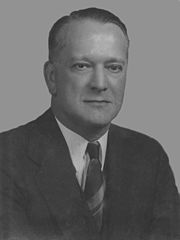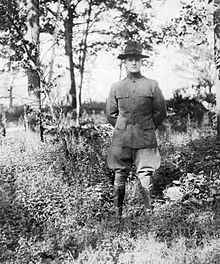- Deming Bronson
-
Deming Bronson 
Deming Bronson in 1941Nickname "Dick" Born July 8, 1894
Rhinelander, WisconsinDied May 29, 1957 (aged 62) Place of burial Arlington National Cemetery Allegiance United States of America Service/branch United States Army Years of service 1916-19? Rank First Lieutenant Unit 364th Infantry Regiment, 91st Division Battles/wars World War I Awards Medal of Honor Deming Bronson (July 8, 1894 – May 29, 1957) was a United States Army officer who received the United States military's highest award, the Medal of Honor, for his actions in World War I.
Bronson was born on July 8, 1894, in Rhinelander, Wisconsin.[1] He attended the University of Washington where he majored in forestry and, from 1912 to 1916, played on the Washington Huskies football team.[2]
Bronson joined the Army from Seattle, Washington, and by September 26, 1918, was serving in France as a first lieutenant with Company H of the 364th Infantry Regiment, 91st Division. On the first day of the Meuse-Argonne Offensive, near the village of Eclisfontaine, he was wounded by a grenade but continued to fight and helped capture an enemy dugout. Shot in the arm later that day, he refused medical evacuation and remained with his unit through the night. The next morning, after joining a company which was on the front line of an attack, he assisted in the capture of Eclisfontaine and an enemy machine gun position. As the company withdrew, he was wounded a third time by an artillery shell, but again refused to be evacuated and remained with his men all night. Bronson recovered from his injuries and was awarded the Medal of Honor in the office of President Herbert Hoover on November 19, 1929. After the war, Bronson became an executive with a paint company in Ohio and New Jersey, and later worked in the family lumber business in Oregon.[1]
He died May 29, 1957, and is buried at Arlington National Cemetery in Arlington, Virginia. His grave can be found in Section 30, Lot 500.[3]
Contents
Medal of Honor citation
For conspicuous gallantry and intrepidity above and beyond the call of duty in action with the enemy. On the morning of 26 September, during the advance of the 364th Infantry, 1st Lt. Bronson was struck by an exploding enemy handgrenade, receiving deep cuts on his face and the back of his head. He nevertheless participated in the action which resulted in the capture of an enemy dugout from which a great number of prisoners were taken. This was effected with difficulty and under extremely hazardous conditions because it was necessary to advance without the advantage of cover and, from an exposed position, throw hand grenades and phosphorus bombs to compel the enemy to surrender. On the afternoon of the same day he was painfully wounded in the left arm by an enemy rifle bullet, and after receiving first aid treatment he was directed to the rear. Disregarding these instructions, 1st Lt. Bronson remained on duty with his company through the night although suffering from severe pain and shock. On the morning of 27 September, his regiment resumed its attack, the object being the village of Eclisfontaine. Company H, to which 1st Lt. Bronson was assigned, was left in support of the attacking line, Company E being in the line. He gallantly joined that company in spite of his wounds and engaged with it in the capture of the village. After the capture he remained with Company E and participated with it in the capture of an enemy machinegun, he himself killing the enemy gunner. Shortly after this encounter the company was compelled to retire due to the heavy enemy artillery barrage. During this retirement 1st Lt. Bronson, who was the last man to leave the advanced position, was again wounded in both arms by an enemy high-explosive shell. He was then assisted to cover by another officer who applied first aid. Although bleeding profusely and faint from the loss of blood, 1st Lt. Bronson remained with the survivors of the company throughout the night of the second day, refusing to go to the rear for treatment. His conspicuous gallantry and spirit of self-sacrifice were a source of great inspiration to the members of the entire command.[1]
See also
References
 This article incorporates public domain material from websites or documents of the United States Army Center of Military History.
This article incorporates public domain material from websites or documents of the United States Army Center of Military History.
- ^ a b c "Medal of Honor recipients - World War I". United States Army Center of Military History. August 3, 2009. http://www.history.army.mil/html/moh/worldwari.html. Retrieved 2009-09-04.
- ^ O'Donnell, Catherine (September 3, 2009). "University of Washington to dedicate Medal of Honor monument". University of Washington. http://uwnews.washington.edu/ni/article.asp?articleID=51839. Retrieved 2009-09-04.
- ^ "Deming Bronson". Claim to Fame: Medal of Honor recipients. Find a Grave. http://www.findagrave.com/cgi-bin/fg.cgi?page=gr&GRid=6129896. Retrieved 2007-12-23.
External links
- "arlingtoncemetery.net: Deming Bronson". http://www.arlingtoncemetery.net/demingbr.htm. Retrieved September 29, 2010.
- "THE FIFTH CORPS". http://history.amedd.army.mil/booksdocs/wwi/fieldoperations/chapter22.html. Retrieved September 29, 2010.
- "University of Washington Student Senate Resolution". http://senate.asuw.org/legislation/12/R/R-12-26.html. Retrieved September 29, 2010.
Categories:- 1894 births
- 1957 deaths
- Washington Huskies football players
- United States Army officers
- Army Medal of Honor recipients
- Burials at Arlington National Cemetery
- University of Washington alumni
Wikimedia Foundation. 2010.


